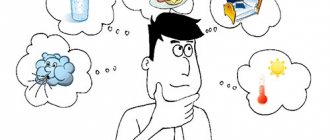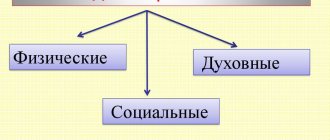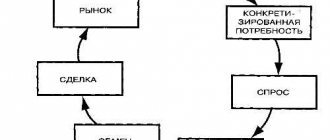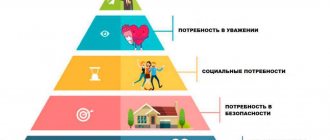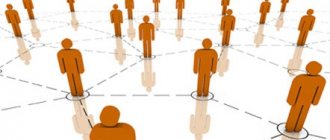Unified State Examination in social studies: thinking and activity; needs and interests
Topic 1.5. Thinking and activity
We continue preparing for the Unified State Exam in Social Studies . Today we will touch on a fairly easy and understandable topic - Thinking and activity. There should be no problems with this topic, as with the entire block Man and Society. Let's get to the theory !
Thinking is a process of brain activity that is characterized by a person’s ability to reason, analyze, compare, generalize and draw conclusions.
Thinking is characterized by the following properties:
- Mediocrity. This property allows us to understand and reveal the essence of any object or phenomenon by moving thoughts from the known to the unknown;
- Generality. Analyzing a large number of objects or information, a person generalizes it. For example: chair, table, sofa, armchair. By summarizing these words, we understand that they all refer to furniture. In other words, generalization is a way of cognition through the identification of common features.
Application of Maslow's pyramid in areas of life
Some people say: “This, of course, is all cool, but why do I need this pyramid?” You may not need it now, but don’t rush to dismiss it. We become familiar with the described scheme from the birth of the baby.
If you have already had such a happy experience, remember whether a 3-6 month old child smiles at you with pleasure or communicates if he is really hungry? Of course not! Until you feed the little “glutton”, there is no talk of any cute baby, you see in front of you an indignant and screaming little man whom you can’t even try to feed!
The same applies to family relationships. If you and your spouse have different needs, sooner or later problems will begin in such a marriage. For example, you like active recreation, she doesn’t. You strive to attend theaters and cultural events, but he spends all his free time playing computer games and cannot put two words together in a sentence...
It is not only the spouses who interact in the family. You also need to build relationships with your teenagers. For example, take the need for belonging in a teenager. In an effort to satisfy her, such “children” can forget about their studies, moral values, and behavior within the framework of the law.
Well, are we all about family, but about family (although this is my favorite topic!)? Let us now consider the sphere of human work. If he struggles and struggles, but is unable to provide for himself while working “on his own,” then he loses calm, restless sleep, anxiety, and everything is bad. Why? Because he doesn’t get enough sleep (minus 1st level) and doesn’t feel secure for tomorrow (minus 2nd level). What kind of development can we talk about?
When you can’t make money this way, find a job, even if you don’t love it, but which will give you the opportunity for several months not to think: “What should I eat tomorrow?”
Why is it that now many advertisements on billboards and pictures on TV are full of half-naked women and slowly flowing, eating or chewing food? It's simple. Marketers successfully use Maslow's pyramid to stimulate your interest in a product through basic physiological needs!
Mental operations (thinking techniques)
- Analysis is the decomposition of a whole into parts;
- Synthesis is the combination of parts into one whole;
- Comparison - correlating objects and highlighting what is common and different in them;
- Generalization - identification of common features;
- Abstraction - highlighting the essential properties of an object while abstracting from the unimportant;
- Induction is the transition from the particular to the general;
- Deduction - transition from the general to the specific;
- Analogy - moving from particular to particular
Classification
The issue related to human needs has been studied by many scientists at different times. In this regard, there are many theories and interpretations that differently describe the relationship between needs, need and the process of satisfying them.
Main types of needs:
- Survival , the strongest instinct.
It is in the nature of every individual to strive to preserve life and protect their loved ones and friends from danger. If there is no guarantee of survival, all other needs fade into the background. - Safety . After a guarantee of survival is received, people begin to feel the need for security: financial , people are afraid of poverty and material losses, so they take actions aimed at overcoming them and increasing their income, physical , all people need housing, clothing and food, emotional , When an individual reaches a minimum safe level of security, he has a need for comfort.
- Free time . People strive to relax more, spend less time at work and take care of themselves.
- Respect . A high-ranking position often motivates people more than a large salary. Lack of respect from others can cause deep feelings of dissatisfaction.
- Love. A person experiences an urgent need to love and be loved. Therefore, people strive to create favorable conditions necessary for the emergence and maintenance of this feeling.
- Self-realization .
A person urgently needs to realize his creative and personal potential. Therefore, throughout their lives, people try to show their abilities and achieve the maximum possible.
According to Simonov
The scientific work of psychologist P. V. Simonov provides the following classification of human needs:
- Vital needs . What does it mean? This includes the need for: water, food, night sleep, protection from threats, the desire to have offspring.
- Social needs. This includes a person’s desire to be respected and loved by society, to belong to one of the social groups and to occupy a worthy place in it.
It is very important to follow the rules and regulations established in a particular community. Without this condition, the very existence of various groups would be impossible. Describing social needs, Hegel pointed to the need of the human being for ideology and religion, which normalize the behavior of a biological unit in society. - Ideal needs. Here we are talking about the individual’s need to understand the world around him, himself, to find his own purpose and determine his place in life. This need motivates people to engage and be interested in art.
These needs are typical for people who are representatives of one of the biological species.
This point also includes the need to save energy, motivating to spend a minimum amount of energy to achieve a certain goal.
As a result, a person begins to show ingenuity, develop and improve technologies.
In some cases, this approach can lead to the development of laziness.
The author divided social and vital needs into two additional categories:
- For others,
- for myself.
Ideal needs, which consist in the desire to know the truth, do not contain such a division.
Because the true meaning of things and processes implies their only form .
When studying human needs in our time, an integrated approach and a full arsenal of scientific methods are used.
Without knowing the reliable reasons for the origin and formation of needs and the degree of their influence on brain activity, it is impossible to effectively solve the following problems:
- prevention and treatment of mental disorders,
- prevention of antisocial and inappropriate behavior,
- proper upbringing.
Activity structure
- Subject is the one who carries out the activity (a person, a group of people or society as a whole);
- Object is what the activity is directed at (phenomenon, object or process);
- Goal is a conscious image of the result for which the activity is carried out;
- Means are resources that help a person achieve the desired result;
- Motive is what motivates a person to act;
- Result is the product resulting from an activity.
Definition
The key word in defining the concept of need is “need”.
Need
- this is the need for certain things, objects of the material world, objects, people, social indicators, in the absence of which a person feels uncomfortable.
Taking into account this definition, neediness, in order to become a need, must meet the following criteria:
- A lack of need causes a feeling of dissatisfaction. A need is something desired, a good.
- Accompanying with emotions: from negative at the first stage to joyful after the need is fulfilled. When we really want something, we get nervous and anxious; when we get what we want, we relax.
- Fixation on the subject of need. Consciousness snatches from reality those things that can satisfy us. For example, if we are hungry, we will focus on the food and the smell of food.
The system of needs is also formed according to special rules:
- Need is common to all living beings on the planet. But the more developed the species, the higher the level of needs. The tree has enough nutrients from the soil, sunlight, and rain watering. Man, as a highly developed animal, needs much more.
- The older the person, the more extensive the list of what is required. A baby can do without things that an adult needs.
- Needs are a strictly hierarchical structure, some are primary, others are secondary.
People's actions are dictated by the presence of a certain need, which is the main motivator of activity. Motivation to get what you want moves a person forward and forces him to act. Everything that has been created by people throughout the history of mankind in politics, economics, art, science is the result of activities to satisfy needs.
The inability to fulfill needs can lead to dependence on their importance for the individual and to the following various consequences:
- Physical death of a person
. If the need for food, sleep, water, air, safety, etc. is not satisfied. - Frustration
is a long-term experience associated with a nervous disorder and can lead to serious psychological problems. An example is the lack of recognition of a person’s merits by society. - Sublimation
- the transition of the energy of dissatisfaction into creation, creativity. For example, the absence of sex is replaced by heavy sports activities.
Thus, needs should be listened to and efforts should be made to realize them.
Activities
There are only four types of activities:
- Labor is an activity aimed at achieving a practically useful result;
- A game is a special type of activity, the goal of which is not so much the result as the process itself;
- Learning is an activity aimed at acquiring new knowledge, skills and abilities;
- Communication is an activity in which there is interaction between people and the exchange of information.
What it is?
What does the concept “need” mean? Human survival depends on the availability of appropriate conditions and means.
If at a certain moment they are absent, this causes a state of need.
Ultimately, the human body begins to respond to irritating factors and become active, since by nature it is programmed to preserve life and further survive.
The state of need that leads to the activity of the subject is called need.
Not a single living creature on the planet has as many needs as humans. To realize them, a person is forced to actively act, as a result of which he develops in different directions and learns about the world around him.
Satisfying a need is accompanied by positive emotions, otherwise negative.
Regardless of gender, nationality or position in society, every person has needs. Some of their types appear at birth , others during later life.
With age, the list of needs changes. Primary ones include the need for air, water, food, and sex. Secondary needs are directly related to psychology. These include the need for respect, success, recognition.
Let's look at examples of test tasks
with theory , now it's time to start practicing . Start completing the first sample task yourself, and then check your answers.
Correct answer: judgment
Correct answer: №4
Correct answer: №3
Correct answer: 32143
Need is a person’s need for something that forms the basis of his existence. Satisfaction of needs is necessary to maintain life.
Criticism
The criticism of Maslow's pyramid comes down to the fact that it is extremely difficult to apply this model in practice. For example, if a person is not able to meet the basic needs of food and a comfortable place to live, this does not mean that he does not strive to realize his talents. Also, not every person seeks recognition in society - for some, a stable job and starting a family are enough.
There are many examples in history when people achieved success in life precisely because their basic needs remained unsatisfied. Thus, living in poverty can force a person to seek acceptance in society, bypassing the needs of security and belonging. And unrequited love can become an incentive to create magnificent works of art. For example, Van Gogh's passion for painting is attributed to failures in love.
The theory is criticized because of its hierarchy and the impossibility of fully satisfying needs. For example, physiological processes will always be relevant - a person constantly needs to drink, eat, and sleep. For some people, only part of the needs may be important.
The fact that over time Maslow completely revised his own theory is often cited in favor of criticism. In later work, he changed the motivational concept and abandoned the multi-level system.
In the new version, Maslow divided human needs into two types:
- “Scarce” (inferior). These are needs caused by a shortage of something and, accordingly, saturated.
- "Existential" (highest). This type of need is dictated by growth and development and is therefore insatiable.
Like the previous theory about the hierarchy of needs, the new vision was presented by the psychologist in the format of an assumption. The author hoped to find confirmation in the future, but did not have time.
The pyramid of needs should not be taken as an unshakable truth. This is not a strict classification of human needs, but an attempt to determine the more and less significant of them. Basic needs will dominate for most people. But different people may have different motivation systems, and for some, higher-level needs will be more important. By the way, according to Maslow, only 2% of people reach the level of self-actualization.
It turns out that Maslow’s pyramid still makes sense, but it does not need to be interpreted literally. For example, in marketing, the pyramid of needs is actively used when developing a sales strategy. The general principle of the theory is interpreted as follows: it is important to monitor trends in needs and direct efforts to satisfy more pressing ones.
Types of needs
There are three types of needs:
- Biological (natural) are the needs that ensure the existence of a person as a biological organism. These needs include: food, water, air, shelter, sleep).
- Social are needs, the satisfaction of which is necessary for a person to maintain his social essence. For example: work activity, cultural leisure, communication with other people).
- Spiritual (ideal) - needs inherent in a person for the development of individuality. This includes: acquiring new knowledge, creativity, art.
American psychologist A. Maslow in his pyramid of needs, among the above types of needs, also placed existential and prestigious needs.
Existential needs. These include: the need for safety, comfort, confidence in the future, and accident insurance.
Prestige needs include : the need for self-esteem, respect from others, recognition, achievement of success, career growth.
Table of needs by A. Maslow
Needs can also be divided into individual and social . Individual needs manifest themselves in an individual person. Social needs consist of the interests of the majority of individuals.
In addition, needs can be reasonable and imaginary (false) .
Reasonable needs (the desire for truth, beauty, knowledge) contribute to the development of personality and the preservation of human health, while imaginary needs lead to the destruction of health and personality degradation. Imaginary needs include : smoking, alcohol, drugs.
How to “apply” the pyramid of human needs in everyday life.
The following are stories from practicing psychotherapists and career strategy consultants about how Maslow's pyramid of needs can be applied in everyday life.
Example 1. Advertising agent.
Not only advertising agents can use the pyramid of needs. We can understand ourselves and understand why we make certain purchases. After all, we often buy not an iPhone, but the opportunity to join the “club of the elite” (belonging to a group); we dream not of a fur coat, but of the opportunity to be cooler than a rival (the need for recognition). Such self-analysis will help not only understand yourself, but also learn to resist persistent advertising and unreasonable spending.
Example 2. Hungry husband.
In fact, this scheme was described in fairy tales: “feed a good fellow, give him something to drink, take a steam bath, and then ask questions.” To paraphrase: satisfy the basic needs according to Maslow’s pyramid and then load your husband with smart conversations.
But this rule applies not only during dinner. Often we work, forget about lunch and rest, begin to solve global problems with a headache, and then we are surprised “something is not working in our head.” Sometimes it’s enough just to have a snack or sleep for half an hour and the brain will reboot on its own.
Example 3: Career changes.
Today, many stories are published online about how important it is to realize oneself in a profession “following the call of one’s heart.” It seems that as soon as you give up the job you hate, your soul will open up and ideas will begin to flow like a fountain. But no. Only success stories are published online, while failure stories mostly remain behind the scenes.
People quit with the desire to change their lives. And a month later they are faced with a problem: their favorite business does not bring the expected income and one day there is simply nothing to buy food with. And then panic begins. But in a panic, it’s somehow impossible to create.
Therefore, career strategy consultants advise finding a job that will bring a stable income and leave time for what you love. To paraphrase: when there is nothing to eat (physiology) and nothing to pay rent with (security), then your favorite activity is not happy.
Example 4. Difficult teenager.
It is especially important for a teenager to feel a sense of belonging to a group. That’s why all these teenage movements, online groups, correspondence, and secret societies arise. Some parents act radically - they forbid it. But forbidding a child to communicate means depriving him of a basic need.
Therefore, psychologists advise not to ban, but to replace groups. For example, instead of playing online, get a teenager interested in sports. Then one group will be replaced by another, and there will be no need to ban anything.
The concept of “interest”
Needs underlie the emergence of interests.
Interest is an individual psychological characteristic of a person, which is characterized by increased attention and purposeful attitude towards the object of need.
Interests are:
- By medium: individual , public and group;
- Focus: economic, political, social and spiritual.
Abraham Maslow - creator of the hierarchy of needs theory
To understand the essence of the theory of the hierarchy of needs, you must first not only familiarize yourself with the biography of its creator, but also try to understand his train of thought. Abraham Maslow was born on April 1, 1908 in the Jewish quarter of Brooklyn. The boy's parents, Rosa Shilovskaya and Samuil Maslov, immigrated to the United States from the Kyiv province at the beginning of the twentieth century.
Abraham Maslow - American psychologist
Abraham is the eldest of seven children of the Maslovs. Being one of the best students at school, Maslow, on the advice of his dad, decides to enroll in law at the City College of New York. Studying in college did not work out, therefore, without completing his first year, in 1928 Abraham transferred to the University of Wisconsin (Madison, Wisconsin) and married his cousin Bertha.
In 1934, Maslow became a doctor of science and began working at Columbia University as a research assistant for the famous behaviorist, educator and psychologist Edward Thorndike. Three years later he took a professorship at Brooklyn College. During his 14 years of work in this position, Maslow not only met many European psychologists hiding in the United States from Nazi persecution, but also decided to begin researching self-actualizing individuals.
Abraham's first studies of self-actualization caused a rather negative reaction in the American psychological community, most of whose members were ardent supporters of behaviorism. Colleagues began to avoid the professor, and reputable and popular psychological journals did not want to publish his articles. In 1951, Maslow changed jobs and became dean of the psychology department at the private research Brandeis University, where the man worked until 1969.
Maslow's ideas began to gain recognition in the 60s. Abraham became so popular and in demand that in 1967 the American Psychological Association elected him as its president.
Abraham Maslow died on June 8, 1970 in California at the age of 62. The cause of death was acute myocardial infarction.


